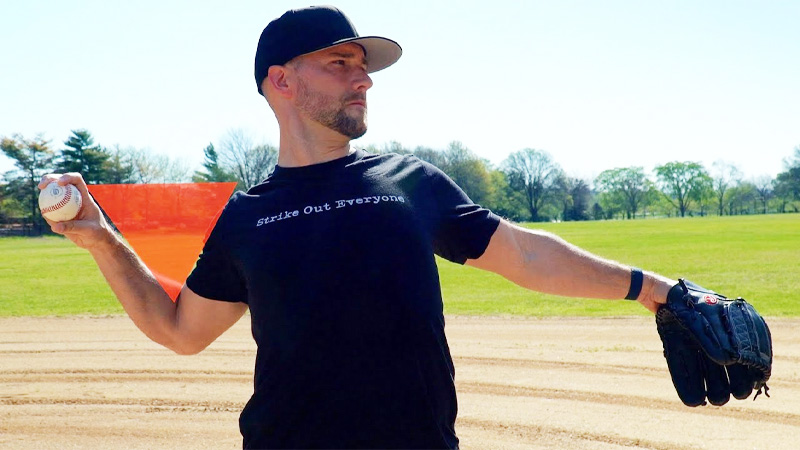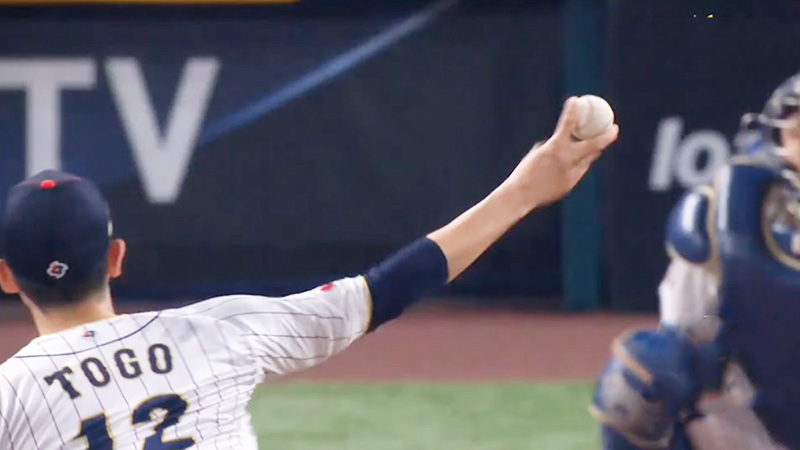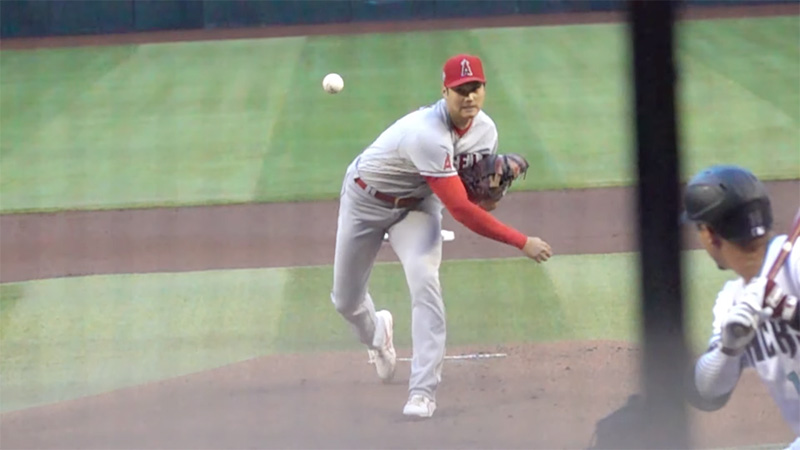In the game of baseball, the art of pitching involves a wide array of pitches designed to deceive and challenge hitters. Among the various pitches at a pitcher’s disposal, the splitter stands out as a particularly intriguing and effective option.
The splitter is known for its ability to sharply drop as it nears home plate, often leaving batters perplexed and unable to make solid contact. So it is quite important in the standard baseball game.
By gaining insights into the mechanics, challenges, and strategic use of the splitter pitch, players and fans alike can appreciate its significance in the game of baseball. So, let’s dive into the fascinating world of the splitter pitch and unravel its secrets.
How Does A Splitter Work?
In baseball, a splitter is a type of pitch that is thrown by a pitcher. It is a variation of the fastball and is intended to deceive the batter with its movement.
A splitter is thrown with the same arm action as a fastball, but at the last moment, the pitcher applies pressure to the ball with their fingers, causing it to split or dive downward as it approaches the plate.
This downward movement can be sudden and sharp, making it difficult for the batter to make solid contact. The splitter is an effective pitch for inducing ground balls and generating swings and misses.
Here’s a step-by-step breakdown of how a splitter works in baseball:
Grip
The pitcher begins by gripping the baseball with a split-finger grip. The index and middle fingers are positioned on the seams of the ball, similar to a two-seam fastball grip.
However, instead of gripping the ball tightly, the pitcher spreads the two fingers slightly apart, creating a gap or split between them.
Arm Action

The pitcher goes through the usual pitching motion, generating arm speed and using a similar arm action to that of a fastball. This deceptive arm action is essential to make the pitch look like a fastball to the batter.
Release
As the pitcher reaches the release point, the fingers play a crucial role. The pitcher maintains the split-finger grip until the last moment.
Just before releasing the ball, the pitcher applies pressure with the index and middle fingers in opposite directions. This pressure differential is what causes the ball to split or dive downward.
Splitting Action
As the pitcher releases the ball, the split-finger grip and the applied pressure cause the baseball to rotate differently than a fastball.
This rotation, combined with the grip, creates a disturbance in the airflow around the ball, resulting in a drag force. The drag force causes the ball to slow down and drop abruptly as it approaches the plate.
Deception
The primary goal of a splitter is to deceive the batter. The pitcher’s arm action and grip closely mimic a fastball delivery, leading the batter to expect a pitch with more velocity.
However, the late downward movement of the splitter catches the batter off guard, causing them to swing early or above the pitch. This deception often leads to weak contact or swings and misses.
Weak Contact
Due to the splitter’s slower velocity and sharp downward movement, hitters tend to make contact with the ball ahead of the sweet spot on the bat.
As a result, the contact is often weaker, leading to pop-ups, ground balls, or foul balls. The desired outcome for the pitcher is to induce weak contact and limit the effectiveness of the hitter’s swing.
The splitter is a deceptive off-speed pitch that relies on the pitcher’s grip, arm action, and release to create a sharp downward movement. Its objective is to fool the batter into swinging early or above the pitch, resulting in weak contact and potential outs for the pitching team.
The Physics Behind the Movement in Splitter

Go through the following part of this article to get more knowledge on this matter.
The Influence of Spin on the Ball’s Trajectory
Spin plays a crucial role in determining the trajectory of a splitter pitch. The spin generated by the split grip and throwing motion affects how the ball moves through the air. Backspin, in particular, influences the ball’s behavior by creating a layer of turbulent air above it.
This layer of turbulent air, known as the Magnus effect, creates an area of low pressure above the ball, reducing its tendency to rise and allowing it to maintain a relatively straight or downward path.
Creating Backspin for Reduced Rising and Increased Sinking
The split grip and throwing motion of a splitter pitch are designed to create backspin on the ball. Backspin occurs when the top of the ball is spinning in the opposite direction of its flight.
This backspin creates the Magnus effect mentioned earlier, which counteracts the force of gravity and reduces the ball’s tendency to rise. As a result, the splitter sinks or drops more sharply than a fastball, making it more challenging for batters to make solid contact.
The Effect of Air Resistance on the Ball’s Path
Air resistance, or drag, also plays a role in the movement of a splitter pitch. As the ball moves through the air, it encounters resistance that can influence its trajectory.
The shape of the ball, the velocity at which it is thrown, and the spin generated by the grip all affect the magnitude and direction of the air resistance.
The combination of backspin and air resistance on the lower side of the ball creates an upward force, further contributing to the downward movement and sharp drop of the splitter.
The Forces That Cause the Splitter to Drop Sharply
The forces acting on a splitter pitch contribute to its distinct downward movement. The combination of backspin, which creates low pressure above the ball, and air resistance, which creates an upward force below the ball, causes the pitch to drop sharply.
These forces counteract the natural effect of gravity, making the ball’s trajectory more vertical and difficult for batters to track. The interplay of spin, air resistance, and gravity is what gives the splitter its unique and deceptive movement, making it a valuable weapon for pitchers.
Hitting Challenges and Deception in Splitter
Hit the following section to get more information on hitting challenges and deceptions by splitters.
How the Splitter Deceives Batters
The splitter pitch is designed to deceive batters due to its deceptive appearance. It closely resembles a fastball in terms of arm speed and release, making it challenging for batters to identify and react to the pitch.
The grip and throwing mechanics used in the splitter allow pitchers to hide the ball until the last moment, giving the batter less time to recognize the pitch type and adjust their swing accordingly. This element of deception makes the splitter an effective tool for keeping batters off balance.
Disrupting a Batter’s Timing
One of the key challenges for hitters facing a splitter is the late and sudden movement of the pitch. The ball appears as a hard-thrown pitch, similar to a fastball, but its downward drop occurs late in its trajectory.
This late movement disrupts the batter’s timing, as they have already committed to their swing based on the initial appearance of the pitch.
The late-breaking downward movement can cause hitters to swing over the ball or mistime their swing, resulting in swings and misses or weakly hit balls.
Difficulty in Making Solid Contact for the Pitch’s Downward Drop
The sharp downward drop of the splitter makes it difficult for hitters to make solid contact. The ball’s trajectory changes abruptly, causing the batter’s swing path to be misaligned with the ball’s new location.
As a result, batters often make contact with the bottom half of the ball, leading to weakly hit ground balls or pop-ups. The downward movement of the splitter creates a challenge for hitters to square up the pitch and drive it with power.
Potential Outcomes for Hitters
When facing a well-executed splitter, hitters have limited options for success. The late-breaking movement and the difficulty in predicting the pitch’s location often lead to swings and misses.
The combination of the splitter’s drop and the batter’s mistimed swing can result in strikeouts. Additionally, due to the downward movement, batters may make contact with the ball but produce weak ground balls due to the mismatch in the swing plane and pitch location.
The challenges posed by the splitter pitch help batters appreciate the skill required to hit it effectively, while pitchers can leverage its deceptive movement to keep batters guessing and generate favorable outcomes.
Mastery and Control of Splitter
Check out the below aspects related to mastery and control in the works of a splitter in baseball.
The Difficulty of Controlling the Splitter
Mastering control over the splitter pitch can be a challenging endeavor for pitchers. The unique movement of the splitter, with its sharp downward drop, adds an extra layer of complexity to its execution.
The combination of grip, spin, and throwing mechanics required to generate the desired movement demands precise control.
The inherent movement of the pitch can sometimes lead to inconsistencies in location and trajectory, making it important for pitchers to invest significant time and effort into honing their control of the splitter.
Importance of Practice and Consistency
Practicing and developing consistency in executing the splitter pitch is essential for pitchers aiming to harness its effectiveness.
Repetition and deliberate practice allow pitchers to refine their mechanics and develop muscle memory, enabling them to consistently execute the pitch with the desired movement.
Consistency in grip, arm speed, and release point is crucial for achieving control and accuracy with the splitter. By dedicating themselves to consistent practice, pitchers can refine their command over the pitch and improve their ability to locate it precisely where intended.
Consequences of a Poorly Executed Splitter Hanging Over the Plate
A poorly executed splitter that hangs over the plate can have unfavorable consequences for pitchers. When a splitter fails to drop sharply and remains elevated, it becomes more hittable for batters.
Hanging splitters lose their deceptive qualities and often result in flatter trajectories, allowing hitters to make solid contact and drive the ball with greater authority.
Batters can take advantage of these mistakes, potentially leading to hard-hit line drives, extra-base hits, or even home runs.
Therefore, the consequences of a poorly executed splitter emphasize the importance of consistent execution and the need for pitchers to maintain control over the pitch to minimize potential risks.
FAQs
How do pitchers develop command and control over the splitter pitch?
Pitchers develop command and control over the splitter pitch through consistent practice and repetition. They focus on maintaining a consistent grip, release point, and throwing mechanics to ensure accuracy and desired movement.
Can all pitchers effectively throw a splitter?
While the splitter can be a highly effective pitch, not all pitchers are able to throw it with success. The grip and throwing mechanics required for the splitter may not be suitable for every pitcher’s hand size, arm slot, or skill set. It often requires dedicated practice and a level of comfort and proficiency to execute the pitch effectively.
Are there any potential risks or downsides to throwing the splitter pitch?
Yes, there are potential risks and downsides to throwing the splitter pitch. If not executed correctly, the splitter can hang over the plate, becoming an easier pitch for hitters to recognize and hit hard.
Inconsistent control or grip variations can also lead to unintended movement or reduced effectiveness. Pitchers must strike a balance between taking advantage of the pitch’s movement and maintaining control.
Can the splitter pitch put additional strain on a pitcher’s arm or increase injury risk?
Like any pitch, the splitter pitch carries some inherent risk of strain or injury if not thrown properly or excessively. The unique grip and throwing motion of the splitter may place different stresses on the arm compared to other pitches. Pitchers should work closely with coaches and trainers to ensure proper mechanics and monitor workload to minimize the risk of injury.
Conclusion
The splitter pitch in baseball is a formidable weapon in a pitcher’s arsenal. Its unique characteristics, including its deceptive appearance and sharp downward movement, make it a challenging pitch for batters to handle effectively.
The split grip, throwing motion, and understanding of the physics behind the pitch contribute to its effectiveness. Their ability to disrupt hitters’ timing, keep them off balance, and generate swings and misses or weakly hit balls make it a valuable tool for pitchers.
By continually refining their skills and staying knowledgeable about the pitch, pitchers, and batters can strive to maximize their performance on the baseball field. So, keep enjoying your favorite game, and best wishes.







